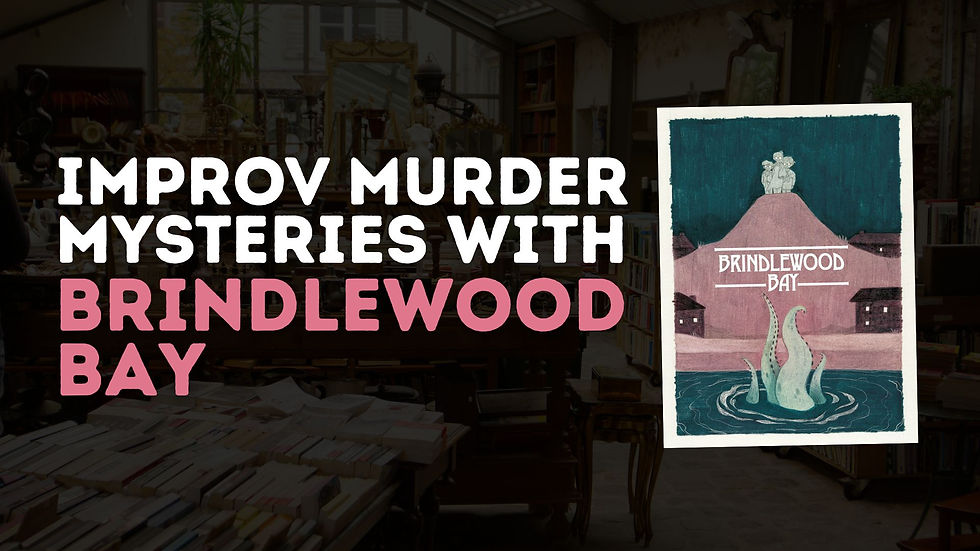Improv Murder Mysteries with Brindlewood Bay
- Elliot Freeman

- Aug 9
- 4 min read

We’ve all got a backlog of books on our to-be-read pile and games in our Steam library with zero playtime. Every once in a while one of them escapes. In my case, I finally had the chance to run Brindlewood Bay, a game that’s been burning a hole in my TTRPG backlog for months.
Why did it stick in my head? Maybe it’s the wildly specific premise — you play a book club of elderly widows who solve murder mysteries in their sleepy New England town, ala Murder, She Wrote (if Jessica Fletcher was being stalked in the background by a doomsday cult). Maybe it’s the system itself, which is a lightweight spin-off of the popular “Powered by the Apocalypse” framework where most of the rules can fit on a single handout.
My Confession
More than anything else, though, it’s probably because I’m pretty bad at mysteries. As much as I love the genre, I’m pretty bad at solving them and struggle mightily to write them.
Here’s the thing, though: Chances are good that if you’ve played a mystery-solving mission in a tabletop RPG, you’ve run into the fact that murder mysteries… are often not fun to play. In a book, the author can perfectly control what information you, the reader, are given; in a show or movie, you have an objective look at what’s present in a scene (even if you’re probably being misled or distracted).
In an RPG, though? Everyone is imagining the same space in entirely different ways, no matter how clearly it's communicated. Players will all interpret clues differently, which feels like what happens in the genre, until you remember that it’s really only ever just the author (or director, or whatever) doing the interpreting through the characters. Some groups make it work — and make it work well! — but the degree of difficulty is pretty high.
Solving in Style
In steps Brindlewood Bay in fabulous rhinestone-studded sunglasses and a biker-grannie leather jacket. There are no solutions in Brindlewood Bay’s mysteries; at least, not until you make them. Rather than trying to parcel out just enough information to keep your players on track, the game encourages you to throw out interesting, evocative clues that the players then have to interpret and connect on their own. You don’t know who the murderer is because there isn’t one yet.
You enter the endgame when the players think they have enough clues to solve the mystery. At that point, it’s on the group to connect or explain away the evidence, gaining bonuses for each piece they can successfully incorporate (after they’ve offset the case’s Complexity rating).
It’s a conversation that happens on two levels: Out of game, the players get to put on their author-hats and spin a yarn. In game, the Murder Mavens are having a spirited debate about what they know, poking holes in one another’s theories before coming to an inevitable conclusion.
The results of this Theorize roll help set up what happens next: Fail, and the Mavens are wrong. The killer is free to act immediately, maybe even by murdering the wrongly accused suspect. Succeed and you’ll get the chance to corner the killer, either with an advantage or disadvantage.

The Verdict
Brindlewood Bay’s mystery-solving engine is a clever piece of storytelling tech that I’m eager to steal and apply elsewhere. It perfectly emulates the dramatic build and release of a good murder mystery, leaving room for twists and turns depending on the dice.
That being said, it’s not a perfect fit for every would-be TTRPG sleuth. People who value the mystery as a true mystery might not be on board for a more free-wheeling, loosey-goosey style where the real murderer is the story we told along the way. Hardcore gumshoes who want the visceral mental challenge of figuring out something that’s been hidden from them won’t get the same thrill.
For me, though? It makes a genre accessible to me and my players that I would otherwise struggle with. It captures the spirit and feel of enjoying a mystery more than solving a puzzle, and that’s exactly what I wanted.
Actual Play
When I brought my copy to Gamer’s XP with some character sheets a few weeks ago, my motley group of friends and I sat down to figure out one of the corebook’s sample mysteries: Dad Overboard! They spent the evening grilling rich socialites about the death of their family patriarch, with the Murder Mavens eventually catching the culprit: Allison Krause, devoted wife and mother, motivated by her husband's discovery that the family’s youngest daughter wasn’t his.
Much fun was had by all, and the players even stumbled into their first “Void clue” — a seagull that circled overhead like a buzzard before landing on someone’s wrist and literally saying, in an all-too-human voice: “Void.” These Void clues lead the Murder Mavens deeper into the supernatural conspiracy happening behind the scenes in Brindlewood Bay.
I sat down to run the game because I thought that would exorcise it from my head. Instead, I think it’s bought a little cottage in my brain, and what started as a one shot might have to go for a few shots more. And really, what better praise can you pay a game than the eager need to play out one more story?







Comments